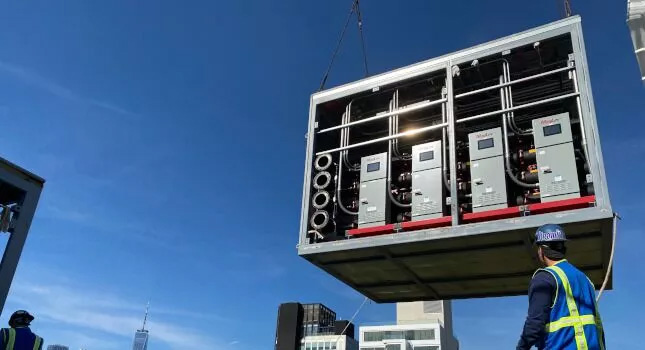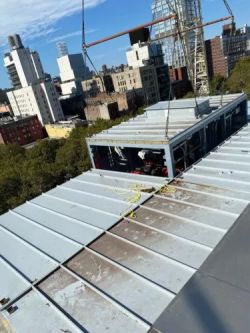What is the future of prefabrication in the U.S. construction industry?
- February 23, 2023
- Best Practices
- Electrical
Prefabrication offers many advantages, and its adoption hinges on support from players across the building and design industry

Learning Objectives
- Learn about the history of prefabrication.
- Identify the benefits of prefabrication.
- Understand the concerns and obstacles impeding widespread adoption of prefabrication; obtain suggestions on overcoming them.
The construction industry, despite its scale, is notorious for declining productivity and slow adoption of technology and now faces further challenges from COVID-19. Is this an industry ripe for a reimagining, a major disruption to the status quo? The answer is a resounding yes and prefabrication is a key component of this transformation.
In this article we look at the prefabrication market in the U.S. and consider the opportunities and challenges associated with wider adoption in the construction market. We ask the question: Should consultants — and the industry as a whole — be doing more to consider prefabrication on projects?
Prefabrication and modular construction — definitions
Prefabrication, or modular construction, is a growing trend in construction. Although the terms are synonymous, people tend to associate prefabrication with individual components, whereas modular is typically used to refer to pre-assembled groups of components — e.g., a modular bathroom unit, a mechanical, electrical and plumbing riser, etc. Here we will look at the prefabrication of MEP services.
Prefabrication in construction is often considered to be a 20th century development, but its origins are actually much older. It is reported that one of the first examples of a modular home stretches back to the 1600s, when a settler in the U.S. brought over his house from England by deconstructing it and shipping it over.
In the 1800s prefab housing was shipped from New York to California to provide accommodation during the Gold Rush. After WWII, prefabrication was used extensively in the United Kingdom to provide housing after the war and many of these houses lasted 70 or more years.
In more recent times we have seen significant developments in this sector resulting from technological developments, including widespread uptake of building information modeling and 3D printing. 2016 saw the opening of the world’s tallest modular building in Brooklyn, New York. In this case, 461 Dean is a 32-story residential tower comprising 323 units.

Construction industry challenges
The construction industry accounts for 13% of global gross domestic product, but it has failed to adapt and thrive the way other sectors such as advanced manufacturing have. Productivity growth has sat at 1% over the past two decades and profit levels remain stagnant at around 5%. While other industries have adapted to changes in markets, technology and digital services, construction has largely remained rooted in the past. Adoption of BIM is not universal, procurement approaches have remained largely unchanged for decades, the market is fragmented and advanced manufacturing techniques are largely bypassed. Projects often run late and over budget and client satisfaction is low.
This is therefore an industry in real need of a fundamental shift in approach and the COVID-19 pandemic has only accelerated the need for change. The scale of the market means that the potential rewards for companies willing to adapt are significant. A report by McKinsey pointed to a $265 billion profit pool available to disrupters in the construction market.
The McKinsey report identified emerging disrupters in the construction market, including:
- Industrialization: new production technology enabling off-site manufacturing.
- New materials: lighter-weight materials, improving logistics.
- Digitalization of process and products: a shift toward data-driven decision making; including widespread adoption of BIM and Industry 4.0.
- New entrants: new players in the market disrupting established systems and approaches.
All four of these disruptors have links to prefabrication.
A separate McKinsey report indicated that the modular market could reach $130 billion by 2030 across the U.S. and Europe, delivering annual cost-savings of $22 billion.
Benefits of prefabrication
The benefits of prefabrication are well documented and as more projects adopt prefabrication, the benefits can start to be quantified. A SmartMarket report from 2020 surveyed companies from across the construction sector about their approach to and views on prefabrication and modular construction. In total the survey generated 608 responses from architects, engineers, general contractors/construction managers, trade contractors and modular builders/manufacturers.
In this section we summarize the benefits of prefabrication and, where appropriate, provide metrics relating to the SmartMarket report.
Improved health and safety: Work is undertaken off-site in a more controlled environment, without the need for working at height. Hot works are greatly reduced and can often be eliminated.
Reduction of waste: Prefabrication allows for much more efficient use of materials, resulting in reduced waste/surplus materials. Use of BIM and advanced manufacturing technology can optimize material ordering and usage. Waste materials can also be tracked and followed through the recycling process.
Schedule improvements: Prefabrication offers much greater control over schedule, as off-site construction of the modules is highly controlled and not subject to external impacts, such as coordination of different trade contractors, weather, rework and delays in site delivery. Once at site, the installation of the modules is fast and does not rely on multiple trades. Downtime due to external factors is minimized. Services can be tested off-site and plant skids can be pre-commissioned, reducing time on-site and preventing rework due to failure.
The design of prefabricated systems can take longer than traditional design, but the increased upfront schedule time reaps rewards on-site, when rework is rarely required.
Figures from the 2020 SmartMarket report show that nearly all (88%) of general contractors indicated that modular construction has a positive impact on project schedule, with 60% reporting a gain of 5% or better. In a similar vein, 65% of architects and engineers reported a positive impact on project schedule performance.
Increased installation quality: Off-site manufacturers typically employ permanent staff across the key trades, with some specialists operating on a contract basis. This means that the installers are well-trained in the prefabrication process and are consistent in approach and quality.
Working in a highly controlled environment — similar to that of an advanced manufacturing facility — results in a much higher quality installation than is achievable on-site.
Reduction in labor force: While this sits in both the advantages and challenges section, the reality is that in many states labor shortages in the construction market are a major limitation. By relying more on prefabrication manufacturer labor (permanent, not related to construction contracts) the demand for local, on-site skilled labor is reduced.
Improved control over project cost: Certainty over material requirements, improvements in schedule and less rework all combine to improve cost control and, typically, overall cost reductions.
Figures from the 2020 SmartMarket report show that nearly all (91%) of the general contractors indicated a positive impact of modular construction on project cost, with 48% reporting a 10% or better reduction in cost. Likewise, 47% of architects and engineers reported a similar positive impact on project cost.
Reduced site traffic: Fewer deliveries to the site, thanks to consolidated deliveries and reduced labor movement, result in increased health and safety both on the site and in the local road network, along with reduced pollution.
Prefabrication challenges
Despite well-documented advantages of prefabrication, a number of challenges and obstacles impede widespread adoption. First and foremost is a prevailing attitude that prefabrication is “cookie cutter” and that it is only applicable to certain projects — typically those with budget or spatial challenges. In fact, prefabrication can be used in the most bespoke of projects, as the off-site fabrication can facilitate the delivery of highly specialized elements, although repeatable elements bring greater schedule and cost benefit.
Linked to this is a split between urban and rural sites — often in rural locations there is more space and therefore less of an impetus to reduce lay-down space, storage and deliveries.
There can also be issues surrounding building codes and the authority having jurisdiction’s approach. Some AHJs are reluctant to accept prefabrication. Teams also have to factor in the additional time required for off-site inspections. For example, in New York state, there is a separate body for inspecting prefabrication, not linked to the building department.
Other concerns revolve around reduced site labor and potential loss of jobs — although in many states the lack of construction workers is an issue. Not surprisingly, unionized states have a lower adoption rate.
Ongoing prefabrication involvement
On a recent project, Mount Sinai Beth Israel Comprehensive Behavioral Health Center, Syska designed a prefab outdoor chilled water plant, which was rigged up on the roof. The prefab skid uses modular multistack chillers. As part of the design, the team incorporated refrigerant pumps into each module, which eliminated the plate and frame heat exchanger for free cooling. This is because the pumps perform well above the 40% efficiency improvement achieved with a plate and frame heat exchanger when condenser water temps are 45°F.
The chilled water skid was built by Epsilon and installed by LendLease.
With more projects using prefabrication, the benefits are becoming quantifiable and the metrics demonstrate significant positive impacts. Furthermore, the construction industry is at a critical juncture and significant financial benefits exist for disruptors and early adopters.
If the construction industry is serious about making a sea change, it is not just about contractors pushing prefab, or designers making due consideration — it requires all industry players to engage:
- Clients and investors: Drive prefabrication through intelligent procurement, setting briefs that demand innovation and ensuring positive engagement from all parties across the project life cycle.
- Modular manufacturers and developers: Look at scaling quickly to meet demand; partner to productize.
- Material suppliers: Innovate, bring lightweight products to market and engage with prefabrication manufacturers.
- Authorities, institutes: Update building codes and approaches to standardize prefabrication; remove any existing roadblocks from a code perspective.
- Consultants/designers: Understand key parameters for development of services (or other) modules; e.g., bend radii, framing size, valve arrangements, etc. and factor into base design.
Syska Hennessy is a CFE Media content partner.
View the original article and related content on Consulting Specifying Engineer